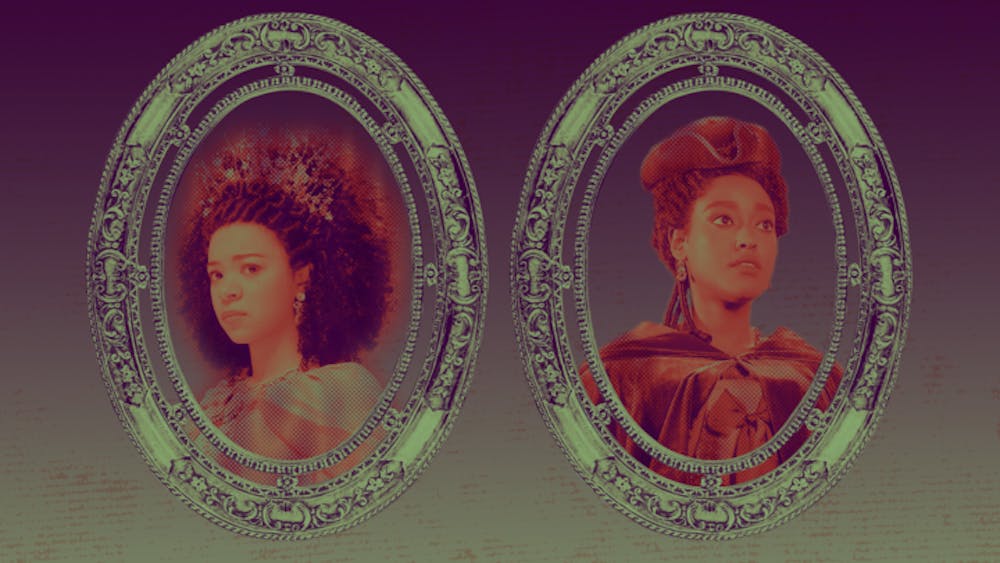“Dearest Gentle Reader, this is the story of Queen Charlotte from Bridgerton. It is not a history lesson. It is fiction inspired by fact. All liberties taken by the author are quite intentional. Enjoy.”
The opening lines of the latest Bridgerton addition, a spin–off series dedicated to the backstory of Queen Charlotte and King George III, read as a clear message to all those quick to criticize the inaccuracies of their portrayals. Perhaps show creators were nervous of how their interpretations of real people would be received. After all, the Bridgertons were never a real family, but the king and queen of England certainly were. Or, perhaps the show creators wanted the “liberties” they took to stand on their own as a clear and politically deliberate decision. Regardless, Queen Charlotte: A Bridgerton Story, with its unfolding of the “Great Experiment,” is arguably the most ambitious Bridgerton project so far.
Despite skirting the edges of how the Britain of Bridgerton acted as a “color–blind” society, with only a few comments in first two seasons of the original series, the crux of Queen Charlotte’s plot relies on this phenomenon. Or rather, the fact that this fictional Britain was once not too different from the Britain of history. The choice to portray the queen as a Black woman plays on rumors speculating that the real Queen Charlotte was from African descent.
The pace of the show moves fast: within the first episode a young Charlotte, portrayed by India Ria Amarteifio, arrives in Britain on the day of the royal wedding. Soon to be queen, she’s inspected by Princess Augusta, her future mother–in–law, who remarks that “She is very brown.” She follows up with, “You did not say she would be that brown.” Despite her comments, Princess Augusta doubles down on the marriage. To save face, the Princess and Parliament set up the “Great Experiment,” where Black families from Britain would be granted royal titles to help normalize Charlotte’s crowning as queen.
The bulk of Charlotte’s own plot revolves around her marriage to King George III, who she soon discovers struggles greatly with mental illness, or “madness,” as they refer to it in the show. Admittedly, her isolation from the outside world leaves her seemingly unaware of the changes taking place. Though her demand that a portraitist paint her skin darker than the pale version he had already created suggests she is not ignorant to society’s expectations. It is notable, however, that despite Princess Augusta’s reluctant acceptance of Charlotte by this point, she encourages the portraiture to paint the queen even paler. And despite early movement within Parliament, resistance to racial equality persists.
The show opts instead to make a young Agatha Danbury, now Lady Danbury and member of the Queen’s court, as the de facto leader of the “Great Experiment.” The King and Queen may be the face of the movement, but Lady Danbury is leading the charge. A young wife and mother, Agatha and her husband receive lord and lady status—a title which Agatha, played by Arséma Thomas, uses to help solidify the precarious nature of the Great Experiment. She proves herself to be smart, ambitious, and acutely aware throughout the series how delicate her position is. Though the show never ventures further than passive aggressive social niceties, Agatha faces the brunt of the prejudices portrayed in the show. Both her place as a woman and as a Black person are used to brush her off. But she’s quick to earn the loyalty of Queen Charlotte and the begrudging admiration of Princess Augusta, and always seems to be miles ahead of everyone else.
About her character, Thomas said, “When you think of women, you think of white women. When you think of Black, you think of Black men, and where does the Black woman fit? And to see her take up space and to see her win doing that–it's not a cautionary tale, but rather something that should be galvanizing other Black women to demand the things they want.”
And demand and get the things she wants, Lady Agatha Danbury does. She hosts the first ball of the season, against the wishes of Princess Augusta and despite the white women of the court’s rejection, and does so successfully. After the death of her husband, she introduces her four–year–old son as Lord Danbury and does not even give Parliament a chance to deny her family the inheritance rule (in which the title of the predecessor is handed down to this successor). Lady Danbury is a compelling character with a strong moral compass and incredible perseverance, and she stands as a testament to the capabilities of Black female characters within the genre.
Queen Charlotte: A Bridgerton Story not only delivers the exciting and heated love story that is expected of all Bridgerton projects, but it tackles the issue of equalizing an unequal society while remaining an overall light atmosphere. For those looking for a deeper dive, or perhaps a historically accurate look at British royalty, this is not the show. But for those who love the thrill of a will they won’t though and expected more from the previous seasons’ colorblind society, it’s an endearing amalgamation of those two concepts. It’s especially interesting given that the original book series featured almost entirely white characters and author Julia Quinn appeared hesitant to introduce people of color in her novels, describing it as “tricky.”
The on–screen adaption, however, has not appeared to struggle with including people of color. And although the show is guilty of never dipping too far below the surface in fear of jeopardizing the ultimately romanticized version of history it wants to tell, Queen Charlotte and the rest of the Bridgerton series are not shy or apologetic for casting people of color in leading roles in a genre typically dominated by white bodies. That is, in its own way, revolutionary.







